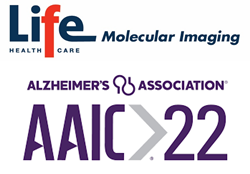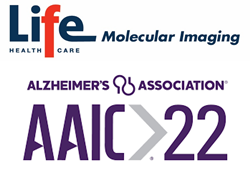
Life Molecular Imaging @ AAIC 2022
PET Neuroimaging is broadly expanding, revealing new insights into pathophysiology and providing important biomarker data for diagnosing patients and in therapeutic clinical trials
BERLIN (PRWEB)
July 29, 2022
Life Molecular Imaging (LMI) announces today that new research results on its approved and investigational positron emission tomography (PET) neuroimaging tracers will be presented at the Alzheimer’s Imaging Consortium (AIC) meeting and the Alzheimer’s Association International Conference (AAIC) in San Diego (July 30 – August 4, 2022), the biggest and most influential international meeting dedicated to advancing dementia science.
The contributions cover twelve (12) presentations demonstrating the utility of its approved compound Neuraceq® (florbetaben F18 injection), thirteen (13) presentations supporting the potential of its investigational tau tracer 18F-PI-2620 and one (1) presentation highlighting first-in-human data from its investigational neuroinflammation imaging tracer 18F-DED.
LMI is also proud to be contributing with The Amyloid imaging to Prevent Alzheimer’s Disease (AMYPAD) initiative to the AAIC program. A virtual featured research session entitled “Progressing the clinical and technical value of amyloid PET in dementia – the AMYPAD experience” will be held on August 1st.
LMI in conjunction with Clario will host a reception and presentations of tau PET imaging, quantification and use in clinical trials featuring Dr. Victor Villemagne.
“We are impressed by the data that research groups around the world have collected over the last year,” said Dr. Andrew Stephens, MD, PhD, CMO of Life Molecular Imaging. “PET Neuroimaging is broadly expanding, revealing new insights into pathophysiology and providing important biomarker data for diagnosing patients and in therapeutic clinical trials.”
Datasets involving LMI compounds presented at the AAIC conference include the following presentations:
Amyloid-PET Neuroimaging presentations involving Neuraceq® (florbetaben F18 injection):
July 30, 2022 (AIC)
- Holy et al., Non-invasive quantification and SUVR validation of [18F]-florbetaben with total-body EXPLORER PET (Oral #IC_O-07-03, Ballroom 20D – San Diego Convention Center, 2:40pm – 2:55pm)
July 31, 2022
- Hönig et al., Inverse relationship between education and amyloid burden in individuals with subjective cognitive decline plus and mild cognitive impairment (Virtual Poster, 7:00am – 11:55pm)
- Altomare et al., The use of amyloid-PET in memory clinic patients: AMYPAD Diagnostic and Patient Management Study (Poster # P1-229, Exhibit Hall — DEF – San Diego Convention Center 9:15am – 4:45pm)
- Petersen et al., Bilingualism Appears to be Protective Against Cognitive Decline Related to Amyloid Burden in Mexican Americans: An HABS-HD Study (Oral, Virtual Session (chairs and presenters only – Room 23A) – San Diego Convention Center, 9:27am – 9:39am)
- Sala et al., Validation of a continuous model of amyloid-β CSF/PET discordance across cohorts and PET tracers (Poster # P1-192, 12:00am – 11:59pm)
August 1, 2022
- Holy et al., Non-invasive quantification and SUVR validation of [18F]-florbetaben with total-body EXPLORER PET (Poster #P2-213, 12:00am – 11:59pm)
- Shekari et al., Evaluating the sensitivity of Centiloid quantification to pipeline design and image resolution (Poster #P2-253, 12:00am – 11:59pm)
AMYPAD virtual featured research session “Progressing the clinical and technical value of amyloid PET in dementia – the AMYPAD experience”
- Altomare et al., Steps towards the implementation of amyloid-PET in memory clinics: AMYPAD Diagnostic and Patient Management Study (Oral, Virtual Session (chairs and presenters only – Room 21) – San Diego Convention Center, 9:15am – 9:30am)
- Shekari et al, Evaluating the sensitivity of Centiloid quantification to pipeline design and image resolution (Oral, Virtual Session (chairs and presenters only – Room 21) – San Diego Convention Center, 9:30am – 9:45am)
- Collij et al., Quantitative amyloid-PET measures in a memory clinic population (Oral, Virtual Session (chairs and presenters only – Room 21) – San Diego Convention Center, 9:45am – 10:00am)
- Vallez Garcia et al., First results of the AMYPAD Prognostic and Natural History Study: amyloid-PET centiloids predicts cognitive functioning in a pre-dementia population (Oral, Virtual Session (chairs and presenters only – Room 21) – San Diego Convention Center, 10:00am – 10:15am)
August 3, 2022
- Vallez Garcia et al., First results of the AMYPAD Prognostic and Natural History Study: amyloid-PET centiloids predicts cognitive functioning in a pre-dementia population (Poster # P4-222, 12:00am – 11:59pm)
Tau-PET Neuroimaging presentations involving 18F-PI-2620:
July 30, 2022 (AIC)
- Dore et al., CenTauRz: A standardized quantification of tau PET scans (Oral #IC_O-05-03, Ballroom 20D – San Diego Convention Center, 11:34am – 11:46am)
- Bohorquez et al., In Vivo Head-To-Head Comparison of [18F]GTP1 and [18F]PI2620 in Alzheimer’s Disease (Poster #IC-P-118, Exhibit Hall — DEF – San Diego Convention Center, 12:25pm – 1:40pm)
- Roemer et al., Subcortical tau-accumulation predicts neuronal dysfunction in the cortex based on functional connectivity in 4R-tauopathies (Poster, # IC-P-117, Exhibit Hall — DEF – San Diego Convention Center, 12:25pm – 1:40pm)
July 31, 2022
- Dore et al., CenTauRz: A standardized quantification of tau PET scans (Virtual Poster, 7:00am – 11:55pm)
- Oh et al., One Year Longitudinal Change of Tau Accumulation on [18F]PI-2620 PET in Alzheimer Spectrum (Virtual Poster, 7:00am – 11:55pm)
- Soleimani-Meigooni et al., [18F]PI-2620 PET in four-repeat tauopathies: a preliminary study (Poster # P1-230, Exhibit Hall — DEF – San Diego Convention Center, 9:15am – 4:45pm)
- Mendez-Orellana et al., Tau-PET imaging with 18F-PI-2620 reveals lateralized distribution of tau pathology in critical language regions in patients with early onset of Alzheimer’s disease and patients with primary progressive aphasia (Virtual Poster, 7:00am – 11:55pm)
- Petersen et al., Bilingualism Appears to be Protective Against Cognitive Decline Related to Cerebral Tau in Mexican Americans: An HABS-HD Study (Poster #P1-264, 9:15am – 4:45pm)
August 1, 2022
- Sanabria Bohorquez et al., In Vivo Head-To-Head Comparison of [18F]GTP1 and [18F]PI2620 in Alzheimer’s Disease (Poster #P2-232, 12:00am – 11:59pm
- Chen et al., Generative Adversarial Network-Enhanced Ultra-low-dose [18F]-PI-2620 Tau PET/MR Imaging (Poster # P2-208, 12:00am – 11:59pm
August 2, 2022
- Santibanez et al., Tau PET imaging with 18F-PI-2620 in patients with corticobasal syndrome: a case series (Poster #P3-181, 12:00am – 11:59pm)
August 3, 2022
- Roemer et al., Subcortical tau-accumulation predicts neuronal dysfunction in the cortex based on functional connectivity in 4R-tauopathies (Oral, Ballroom 6A – San Diego Convention Center, 9:15am – 9:25am)
- Santibanez et al, Tau and amyloid PET imaging with 18F-PI-2620 and 18F-Florbetaben in patients with early-onset dementia and healthy controls (Poster #P4-201, 12:00am – 11:59pm)
Neuroinflammation-PET Imaging involving 18F-DED
August 2, 2022
- Katzdobler et al., First-in-human [18F]D2-Deprenyl-PET imaging and GFAP evaluation as biomarkers of reactive astrogliosis in neurodegenerative diseases (Poster #P3-409, 12:00am – 11:59pm)
About Neuraceq® (florbetaben 18F)
Indication
Neuraceq® is a radioactive diagnostic agent indicated for Positron Emission Tomography (PET) imaging of the brain to estimate beta amyloid neuritic plaque density in adult patients with cognitive impairment who are being evaluated for Alzheimer’s disease (AD) and other causes of cognitive decline.
A negative Neuraceq® scan indicates sparse to no amyloid neuritic plaques and is inconsistent with a neuropathological diagnosis of AD at the time of image acquisition; a negative scan result reduces the likelihood that a patient’s cognitive impairment is due to AD. A positive Neuraceq® scan indicates moderate to frequent amyloid neuritic plaques; neuropathological examination has shown this amount of amyloid neuritic plaque is present in patients with AD but may also be present in patients with other types of neurologic conditions as well as older people with normal cognition. Neuraceq® is an adjunct to other diagnostic evaluations.
Limitations of Use
- A positive Neuraceq® scan does not establish the diagnosis of AD or any other cognitive disorder.
- Safety and effectiveness of Neuraceq® have not been established for (i) predicting development of dementia or other neurologic conditions and (ii) monitoring responses to therapies.
Important Safety Information
Risk for Image Interpretation and Other Errors
Neuraceq® can be used to estimate the density of beta-amyloid neuritic plaque deposition in the brain. Neuraceq® is an adjunct to other diagnostic evaluations. Neuraceq® images should be interpreted independent of a patient’s clinical information. Physicians should receive training prior to interpretation of Neuraceq® images. Following training, image reading errors (especially false positives) may still occur. Additional interpretation errors may occur due to, but not limited to, motion artifacts or extensive brain atrophy.
Radiation Risk
Administration of Neuraceq®, like other radiopharmaceuticals, contributes to a patient´s overall long-term cumulative radiation exposure. Long-term cumulative radiation exposure is associated with an increased risk of cancer. It is important to ensure safe handling to protect patients and health care workers from unintentional radiation exposure.
Most Common Adverse Reactions
In clinical trials, the most frequently observed adverse drug reactions in 872 subjects with 1090 Neuraceq® administrations were injection/application site erythema (1.7%), injection site irritation (1.1%), and injection site pain (3.4%).
About PI-2620
Tau deposits, in conjunction with beta-amyloid plaques, represent the other pathological hallmark of Alzheimer’s disease, with tau deposits further playing an important role in other neurodegenerative diseases. PI-2620 is binding to 3R/4R and 4R tau deposits and is a next generation 18F-labeled investigational PET tracer with favourable properties and imaging characteristics. It was discovered in a research collaboration between Life Molecular Imaging and AC Immune, a Swiss-based clinical stage biopharmaceutical company. Life Molecular Imaging has the exclusive, world-wide license for research, development and commercialization of tau PET tracers generated within the discovery program.
About 18F-DED
Neuroinflammation represents a key pathologic mechanism in many neurodegenerative diseases, including AD, movement disorders and multiple sclerosis. In the brain it can be mediated by activated astrocytes (astrogliosis), which show increased activity of the enzyme monoamine oxidase B (MAO-B). The PET tracer [18F]DED is a deuterated deprenyl derivative that was designed to preferentially bind to areas with increased MAO-B activity.
About Life Molecular Imaging (LMI)
Life Molecular Imaging (LMI, formerly Piramal Imaging) was formed in 2012 with the acquisition of the molecular imaging research and development portfolio of Bayer Pharma AG. It is now part of the Alliance Medical Group (a member of the Life Healthcare Group) offering an integrated business including research and development laboratories, a network of cyclotrons, radiopharmacies and imaging facilities. By developing novel PET tracers for molecular imaging, LMI is focusing on a key field of modern medicine. The organization strives to be a leader in the Molecular Imaging field by developing innovative products that improve early detection and characterization of chronic and life-threatening diseases, leading to better therapeutic outcomes and improved quality of life. Please visit https://life-mi.com.
About Life Healthcare Group
Life Healthcare is a global people-centered, diversified healthcare organization listed on the Johannesburg Stock Exchange. Life Healthcare has over 38 years’ experience in the South African private healthcare sector, and currently operates 66 healthcare facilities in southern Africa. Services include acute hospital care, acute physical rehabilitation, acute mental healthcare, renal dialysis, and wellness, occupational health, primary health and emergency medical services. The Group owns Alliance Medical Group, the leading independent provider of medical imaging services (MRI, CT and PET scans) within Europe, operating internationally across 10 countries. Life Molecular Imaging, a division of Alliance is an integrated pharmaceutical business that includes research and development laboratories, access to a network of cyclotrons and radio-pharmacies and imaging facilities, with Life Radiopharma being Alliance’s distributor of radiopharmaceuticals to diagnose many types of diseases. Visit https://www.lifehealthcare.co.za/
Share article on social media or email:

